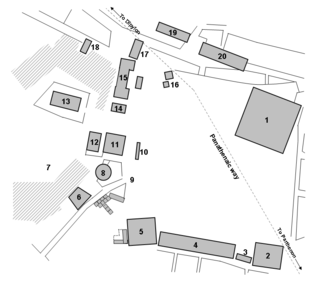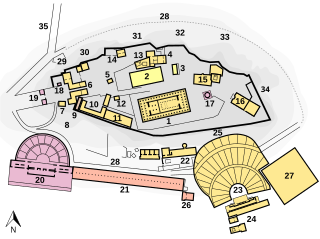Further reading
- Studies in Greek epigraphy and history in honor of Stephen V. Tracy . Edited by Gary Reger, Francis X. Ryan, & Timothy F. Winters. Paris: Ausonius, 2010. ISBN 978-2356130181
Stephen Victor Tracy (born 1941) is an American scholar of Classics specializing in ancient Greek Epigraphy. Inscriptions are one of the most important classes of primary evidence that comes down to us from antiquity. Tracy is best known for devising a method for recognizing the work of individual inscribers. It was long thought that the intractability of the medium (hammer and chisel on marble) made this impossible. But by treating the inscribed letters as a kind of handwriting he has been able to establish careers for many cutters, to join discrete fragments, to date inscriptions more accurately than in the past, and often thereby make it possible to reach a new understanding of historical events.

An abecedarium is an inscription consisting of the letters of an alphabet, almost always listed in order. Typically, abecedaria are practice exercises.

The Panathenaea was a multi-day ancient Greek festival held annually in Athens that would always conclude on 28 Hekatombaion, the first month of the Attic calendar. The main purpose of the festival was for Athenians and non-Athenians to celebrate the goddess Athena. Every four years, the festival was celebrated in a larger manner over a longer time period with increased festivities and was known as the Great Panathenaea. In the years that the festival occurred that were not considered the Great Panathenaea, the festival was known as the Lesser Panathenaea. The festival consisted of various competitions and ceremonies, culminating with a religious procession that ended in the Acropolis of Athens.

The ancient Agora of Athens is the best-known example of an ancient Greek agora, located to the northwest of the Acropolis and bounded on the south by the hill of the Areopagus and on the west by the hill known as the Agoraios Kolonos, also called Market Hill. The Agora's initial use was for a commercial, assembly, or residential gathering place.

The Stoa of Attalos was a stoa in the Agora of Athens, Greece. It was built by and named after King Attalos II of Pergamon, who ruled between 159 BC and 138 BC. The current building was reconstructed from 1952 to 1956 by the American School of Classical Studies at Athens and currently houses the Museum of the Ancient Agora.

The Arch of Hadrian, most commonly known in Greek as Hadrian's Gate, is a monumental gateway resembling—in some respects—a Roman triumphal arch. It spanned an ancient road from the center of Athens, Greece, to the complex of structures on the eastern side of the city that included the Temple of Olympian Zeus.

A prytaneion was seat of the prytaneis (executive), and so the seat of government in ancient Greece. The term is used to describe any of a range of ancient structures where officials met, but the term is also used to refer to the building where the officials and winners of the Olympic Games met at Olympia. The prytaneion normally stood in centre of the city, in the agora.
In ancient Greece the chief magistrate in various Greek city states was called eponymous archon. "Archon" means "ruler" or "lord", frequently used as the title of a specific public office, while "eponymous" means that he gave his name to the year in which he held office, much like the Roman dating by consular years.
"Against Leptines" was a speech given by Demosthenes in which he called for the repeal of a law sponsored by Leptines, which denied anyone a special exemption from paying public charges (leitourgiai). It was probably delivered in the year 355–54 BC. Unusually for Athenian law courts, though Demosthenes wrote the speech for Ctesippus, the son of Chabrias, he probably delivered it himself. It is thus the first speech which Demosthenes delivered in a public case.
The Chalkeia festival, the festival of Bronze-workers, was a religious festival devoted to the goddess Athena and the god Hephaestus. It was celebrated on the last day of Pyanepsion. The festival celebrated Athena and Hephaestus, in honor of both gods as patron deities of Athens, and as deities of handicrafts.
The Inscriptiones Graecae (IG), Latin for Greek inscriptions, is an academic project originally begun by the Prussian Academy of Science, and today continued by its successor organisation, the Berlin-Brandenburgische Akademie der Wissenschaften. Its aim is to collect and publish all known ancient inscriptions from the mainland and islands of Greece.

The Altar of the Twelve Gods, was an important altar and sanctuary at Athens, located in the northwest corner of the Classical Agora. The Altar was set up by Pisistratus the Younger, during his archonship, in 522/1 BC. It marked the central point from which distances from Athens were measured and was a place of supplication and refuge.
Totenpass is a German term sometimes used for inscribed tablets or metal leaves found in burials primarily of those presumed to be initiates into Orphic, Dionysiac, and some ancient Egyptian and Semitic religions. The term may be understood in English as a "passport for the dead". The so-called Orphic gold tablets are perhaps the best-known example.
Marcus Ulpius Eubiotus Leurus was a Roman senator, who was active during the first part of the third century.
Lilian Hamilton "Anne" Jeffery, was a British archaeologist, classical philologist and epigraphist best remembered for her 1961 work The Local Scripts of Archaic Greece. Building on the work of Adolf Kirchhoff and Antony E. Raubitschek, Jeffery surveyed the development of the Greek alphabet from its adoption down to the fifth century BC and in so doing established the chronology of archaic inscriptions.
Ptelea was a deme of ancient Attica of the phyle Oineis, sending one delegate to the Athenian Boule. It is the setting for Menander's Heros.
Leuconoe or Leukonoe, or Leuconoeum or Leukonoion (Λευκόνοιον), or Leukonefs (Λευκονοιεύς) was a deme of ancient Attica of the phyle of Leontis.
Olga Palagia is Professor of Classical Archaeology at the National and Kapodistrian University of Athens and is a leading expert on ancient Greek sculpture. She is known in particular for her work on sculpture in ancient Athens and has edited a number of key handbooks on Greek sculpture.

The Klepsydra of the Acropolis of Athens is a natural spring on the north-west slope of the Acropolis hill, near the intersection of the Peripatos and the Panathenaic Way. It had been in use as a source of water since prehistoric times but sometime in the fifth century BCE the site was developed with several new structures built. The site consisted of the paved court, a well, the covered well-house, a later Roman apsidal well house and a flight of stone-carved steps up to the propylaea. There are several references to the source in ancient literature; Hesychius says of it “Klepsydra is a fountain which was formerly called Empedo”. Empedo, argues Parsons, was the name of the spring and klepsydra the name given to the water made available by the fountain house. It would seem that Empedo was also the name of the tutelary deity of the spring - an Attic nymph. Mention is also made of the fountain by Aristophanes, Pausanias, and Plutarch.

The Peripatos is an ancient pathway that girds the Acropolis in Athens and intersects with the Panathenaic way on the north slope. It connects the shrines that are interspersed around the Acropolis hill. A reading of Thucydides 2.17, which records that the shrines were erected within an area which it was forbidden to build or quarry called the Pelasgian ground, suggests that the peripatos follows the line of the archaic and now vanished Pelasgic wall.

The Cave Sanctuaries of the Akropolis, Athens, are the natural fissures in the rock of the Akropolis hill that were used as sites of worship for deities of the panhellenic pantheon in antiquity. Traditionally a sharp distinction has been drawn between the state religion practised on the summit of the akropolis and the cult practice of the shrines on the lower slopes. Recently, however, interest has burgeoned in the individual religious experience or personal piety in Greek society of which these cult sites may be the expression. The proceeding description follows the order of the shrines from the Klepsydra at the northwest face of the akropolis clockwise via the Peripatos round to the foot of the Nike bastion.